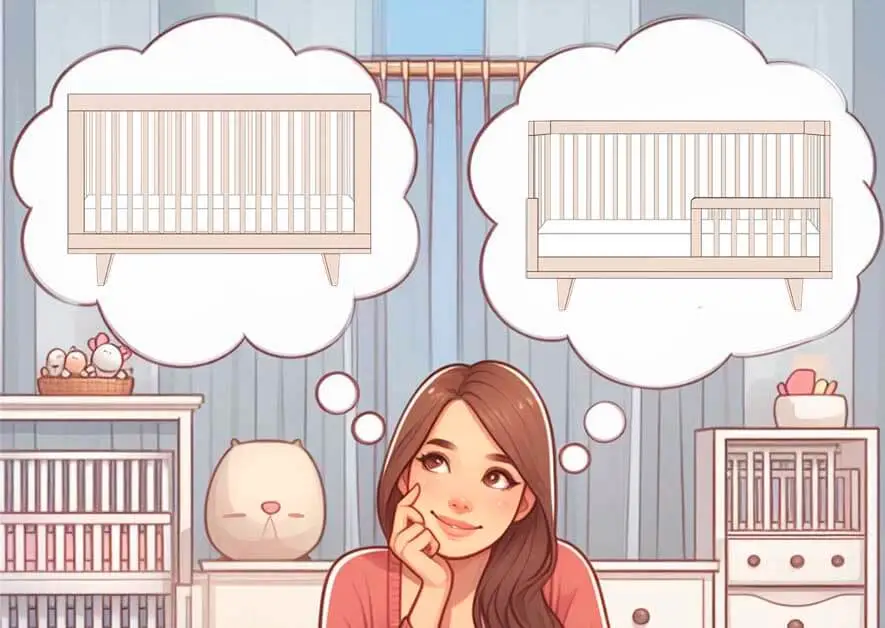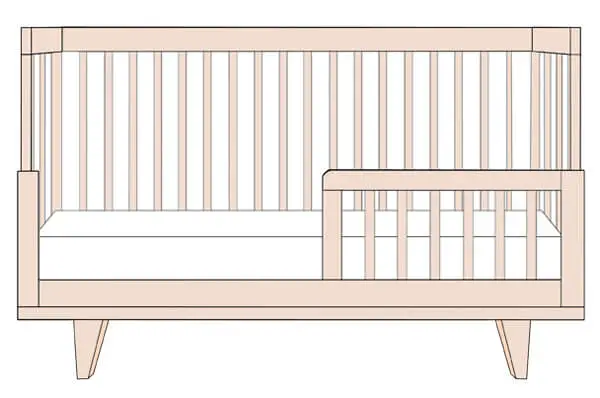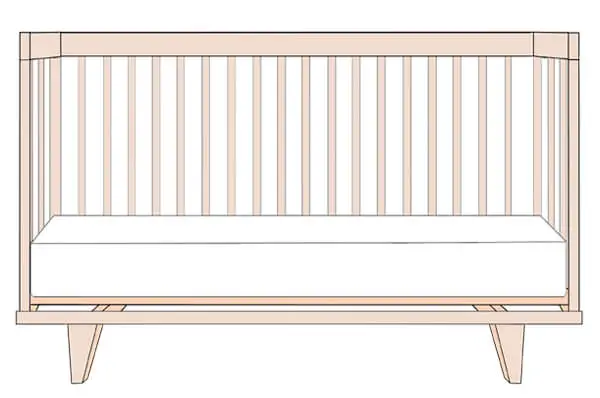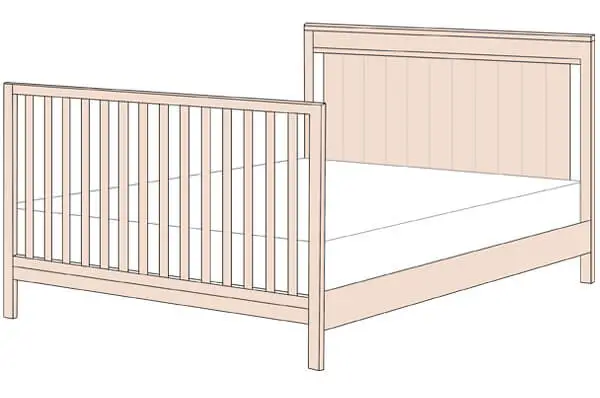
As a parent, one of the most memorable moments is watching your baby sleep peacefully in their crib. I still remember the first night my daughter slept in her crib—you guessed it, it was a convertible one. After all, it is the most popular, versatile, and long-term choice. But what is a convertible baby crib?
In this guide, we will cover everything you need to know, from understanding the best convertible crib options to learning about convertible crib benefits and how to choose the right convertible crib for your needs.
- What is a Convertible Baby Crib?
- Common Convertible Baby Bed Conversions
- Different Types Of Convertible Cribs – Which Convertible Baby Bed is Right for You?
- How Long Can You Use a Convertible Crib?
- How to Choose the Right Convertible Crib? – Expert Tips
- Tips For Safe Sleep In A Convertible Crib – Ensuring Safety in Your Convertible Baby Bed
- Convertible Cribs vs Traditional and Portable Cribs
- How to Transition Your Child from a Convertible Crib to a Toddler Bed
- Growing Up Together
What is a Convertible Baby Crib?
A convertible baby crib is a piece of furniture designed to grow with your child and adapt to their changing needs. It is much more than just a traditional crib, which serves only one purpose: being a bed for the infant.
The convertible model doesn’t become uselles when your child outgrows the crib. Instead, it transforms into a bed for older children, extending its usability from infancy through childhood.
Depending on the type of convertible crib you choose, your convertible crib can transform into one or more of the following beds: a toddler bed, a daybed, a junior bed, a sofa, a twin-size bed, or a full-size bed.
What are the Benefits of a Convertible Crib?
A convertible crib is a smart choice because it saves you money. It grows with your child, so you won’t need to buy new beds as they get older. Plus, it keeps the same style and design, creating a consistent look in your child’s room from baby to toddler.
Common Convertible Baby Bed Conversions
Convertible cribs usually convert into one or more of these three beds:
- Toddler bed
- Daybed
- Full-size bed
1. Toddler Bed:
When your baby outgrows the crib, it is time for the first conversion, which is usually a toddler bed.

For this conversion, you need to remove one of the crib’s sides and replace it with a toddler bed safety guardrail. Unfortunately, in most cases, you will have to purchase a toddler safety rail separately. This adds to the cost. However, it ultimately saves you money in the long run by eliminating the need to buy a completely new bed.
Everything else on the bed stays the same. The toddler bed uses the same mattress support and the same mattress as a crib.
Tip: Some crib mattresses are dual-sided. That means they have a firmer side for a baby and a softer side for a toddler. Dual-sided crib mattresses are a great choice for convertible cribs and are worth your consideration.
2. Daybed:
Once you feel confident that your toddler no longer needs a safety rail, you can remove it and transform your convertible model into a daybed. At this point, the bed has the mattress support set at its lowest point, and there is no front railing. The daybed still uses the same mattress as in the crib and toddler bed.

Almost all convertible baby beds can be converted into a daybed. The process is easy and doesn’t require any additional purchases. All you have to do is remove the front rail and set the mattress in the lowest position.
3. Full-Size Adult Bed:
Most 4-in-1 convertible cribs and some 3-in-1 models can transform into a full-sized adult bed. This final conversion will not utilize many of the crib’s parts. Instead, only the crib’s front and back rails will be used to create the headboard and footboard of the new adult bed. If the adult bed only requires a headboard, then you will need only the back side of the crib.

To convert your crib into an adult bed, you must buy a full-size mattress support and a fitted adult mattress. That is not cheap, and this conversion certainly costs the most.
Different Types Of Convertible Cribs – Which Convertible Baby Bed is Right for You?
Convertible cribs come in various configurations, each offering different levels of adaptability. They are named according to the number of possible conversions you get with one purchase:
- 2-in-1 convertible crib: You get two beds: a crib + 1 bed
- 3-in-1 convertible crib: You get three beds: a crib + 2 beds
- 4-in-1 convertible crib: You get four beds: a crib + 3 beds
2-in-1 Convertible Crib – The Best Convertible Crib for Simplicity
2-in-1 convertible cribs can convert from a crib into one bed, which is usually a toddler bed or a daybed.


They are generally less expensive than 3-in-1 or 4-in-1 options. However, they also do not last as long as those convertible cribs that transform into full-size beds.
3-in-1 Convertible Crib – The Best Convertible Crib for Versatility
3-in-1 convertible cribs can convert from a crib into two of the following options: a toddler bed, a daybed, a junior bed, a twin-sized bed, and a full-size bed. However, they generally come in these two combinations:
- crib + toddler bed + daybed
- crib + daybed + adult bed


A 3-in-1 convertible crib offers more versatility but costs more than the 2-in-1 option. When it comes to lifespan, 3-in-1 cribs that convert to full-size beds last just as long as 4-in-1 convertible cribs. However, 3-in-1 convertible cribs that transform into full-size beds usually do not include the toddler bed phase. This means there is no option for a bed with a toddler bed safety rail, which I consider essential.
4-in-1 Convertible Crib – The Best Convertible Crib for Longevity
4-in-1 convertible cribs can convert from a crib to three different beds. They are the most versatile option and a long-term investment. Although you have to spend a little more at the beginning, it saves you the most in the long run.
Depending on your chosen model, a 4-in-1 convertible crib can transform into four of these beds: a toddler bed, a daybed, a junior bed, a sofa, a twin-size bed, or a full-size bed. However, the most common combination is a crib, a toddler bed, a daybed, and a full-size bed.

It is fascinating that 4-in-1 convertible cribs that convert into full-size adult beds can be the only bed you will ever need for your child. However, adolescents might want to pick their bed in their own style and not use a “crib” anymore.
How Long Can You Use a Convertible Crib?
The longevity of a convertible crib depends on its type and build quality.
Most convertible cribs are designed to support children up to 35 inches tall and/or 50 pounds, which is typically around 5 to 7 years of age. This means a convertible baby bed that converts into a toddler bed and/or daybed can be used for around seven years.
You will need to convert your crib into one of these beds at some point during these seven years. You can tell it’s time to convert the crib when your child starts climbing out of it, typically at around 18 to 24 months old.
And what about convertible cribs that convert into adult beds? Typically, a well-made 4-in-1 convertible crib can be used from birth until your child is a teenager or even an adult, making it a lasting investment.
How to Choose the Right Convertible Crib? – Expert Tips
When deciding on the best convertible crib, consider factors such as price, size, material quality, and safety standards.
When choosing a convertible crib, consider these factors:
- Decide how much you want to spend on a convertible crib. Remember to include the cost of extras like a toddler bed safety rail or mattress support for a full-size bed.
- Make sure the crib fits in your nursery. Also, check if the future bed sizes will fit your space.
- Choose high-quality materials and sturdy construction. The crib will need to transform several times without becoming wobbly or loose.
- Pick a style that also suits toddlers and teens since the bed will be used for many years.
- Ensure the crib meets current safety standards. Look for features like adjustable mattress heights and secure railings.
I also recommend reading a crib buying guide, which you can find here: ‘How to Choose a Crib.’ It has many valuable tips to help you find the best and safest crib for your baby.
Tips For Safe Sleep In A Convertible Crib – Ensuring Safety in Your Convertible Baby Bed
While buying the right convertible crib is essential, knowing how to use it properly is just as important. Proper usage ensures that the crib remains a safe sleeping environment for your child at all stages of their growth.
Here are some tips:
- Use a firm, well-fitting mattress to reduce the risk of suffocation.
- Keep the crib free of pillows, blankets, and stuffed animals.
- Follow the manufacturer’s instructions meticulously during assembly.
- Routinely check for loose parts or damage.
- Lower the mattress as your baby grows to prevent climbing accidents.
- Knowing how to change the crib from a newborn crib to a toddler bed ensures your child always has a safe and cozy place to sleep.
When you are confident in how to use the crib properly, it reduces stress and worry. You’ll know you are providing the best and safest space for your baby to sleep.
Convertible Cribs vs Traditional and Portable Cribs
I have made a comparison chart highlighting the advantages and disadvantages of convertible cribs, traditional cribs, and portable cribs on wheels:
| Feature | Convertible Cribs | Traditional Cribs | Portable Cribs on Wheels |
|---|---|---|---|
| Versatility | Can convert to toddler bed, daybed, or full bed | Fixed structure, serves as crib only | Highly versatile, easy to move around |
| Longevity | Grows with the child and lasts through several stages | Typically used only until the child outgrows the crib | Shorter lifespan, often outgrown quickly |
| Cost | Can be less sturdy due to its lightweight design | Requires purchase of new beds as child grows | Lower initial cost, but may need replacement sooner |
| Ease of Use | May require tools for conversion | Simple and straightforward | Easy to move, often folds for storage |
| Portability | Not portable, designed to stay in one place | Not portable, designed to stay in one place | Highly portable, wheels allow easy movement |
| Sturdiness | Generally very sturdy and stable | Very sturdy and stable | Requires significant space, especially in full-bed mode |
| Safety | Meets strict safety standards | Meets strict safety standards | Meets safety standards but can be less robust |
| Space Requirements | Requires significant space, especially in full bed mode | Requires significant space | Requires less space, ideal for small rooms or travel |
| Design Options | Wide variety of styles and finishes | Wide variety of styles and finishes | Limited design options |
How to Transition Your Child from a Convertible Crib to a Toddler Bed
Transitioning your baby from a crib to a toddler bed is a significant milestone. Here are some steps to make the process as smooth as possible:
- Choose the right time for the transition. It’s often best to wait until your child shows signs of readiness, such as climbing out of the crib or when they reach about 2-3 years old.
- Involve your child in the process of the crib’s conversion to create excitement. You can also choose a new bedding together.
- Keep the same bedtime routine as you had with a crib. Consistency helps children feel secure, so stick to familiar activities like bath time, storytime, and a goodnight kiss.
- Praise and encourage your child for sleeping in the “big kid” bed. Positive reinforcement can help ease any anxiety they might have.
- Be patient and consistent. If your child gets out of bed, calmly and gently guide them back without giving too much attention to the behavior.
- Respond consistently if your child wakes up and leaves their bed. Gently guide them back to bed and reassure them, but keep interactions brief and calm.
- To help your child feel secure, allow them to have comfort items like a favorite blanket or toy in the bed. They are big enough now to have it safely in their bed.
Growing Up Together
If you’re looking for a cost-effective choice that will last throughout your child’s early years, a convertible crib is the one you are looking for.
Our expert tips are here to help you find the perfect convertible crib for your baby. From selecting the right type to understanding how to use it safely, we’ve got you covered. With our guidance, you can make an informed decision and provide the best for your little one.
And remember, always prioritize quality and safety when choosing a crib!
